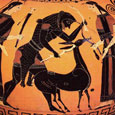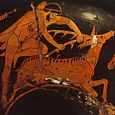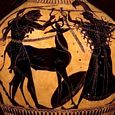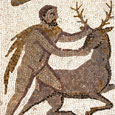ELAPHOS KERYNITIS
Greek Name
Ελαφος Κερυνιτις
Transliteration
Elaphos Kerynitis
Latin Spelling
Elaphus Cerynitis
Translation
Cerynitian Hind
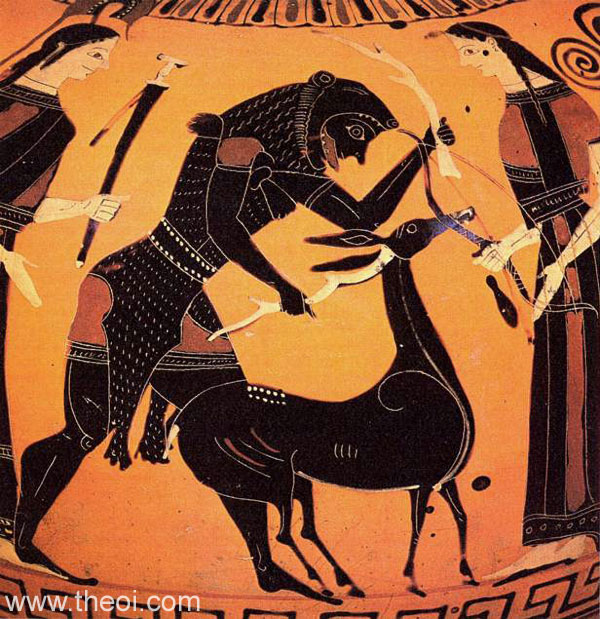
THE ELAPHOS KERYNITIS (Cerynitian Hind) was a golden-horned deer sacred to the goddess Artemis. Herakles was sent to fetch it as one of his twelve labours. After chasing the animal for a full year he finally captured it on Mount Artemision in Arkadia (Arcadia). The goddess Artemis complained about the treatment of her deer whose horn had broken off by the hero in the struggle. He nevertheless managed to persuade her to let him borrow it for the completion of his Labour.
According to some the hind was one of five golden-horned deer gifted to Artemis by the Nymph Taygete. The other four drew the chariot of the goddess.
The hind may once have been assigned a Constellation like the other beasts of Herakles' labours.
FAMILY OF THE HIND
PARENTS
Nowhere stated
ENCYCLOPEDIA
CERYNITIAN HIND. The stag of Ceryneia in Arcadia. This animal had golden antlers and brazen feet. It had been dedicated to Artemis by the nymph Taygete, because the goddess had saved her from the pursuit of Zeus. Heracles was ordered to bring the animal alive to Mycenae. He pursued it in vain for a whole year: at length it fled from Oenoë to mount Artemisium in Argolis, and thence to the river Ladon in Arcadia. Heracles wounded it with an arrow, caught it, and carried it away on his shoulders. While yet in Arcadia, he was met by Apollo and Artemis, who were angry with him for having outraged the animal sacred to Artemis; but Heracles succeeded in soothing their anger, and carried his prey to Mycenae. According to some statements, he killed the stag. (Apollod. ii. 5. § 3; Diod iv. 13; Callim. Hymn. in Dian. 100, &c.; Ov. Met. ix. 188; Virg. Aen. vi. 803; Pind. Ol. iii. 24, 53; Eurip. Herc. Fur. 378.)
Source: Dictionary of Greek and Roman Biography and Mythology.
ALTERNATE NAME
Greek Name
Ελαφος Χρυσοκερος
Transliteration
Elaphos Khrysokeros
Latin Spelling
Elaphus Chrysocerus
Translation
Golden Horned Deer
CLASSICAL LITERATURE QUOTES
CERYNITIAN HIND THE THIRD LABOUR OF HERACLES
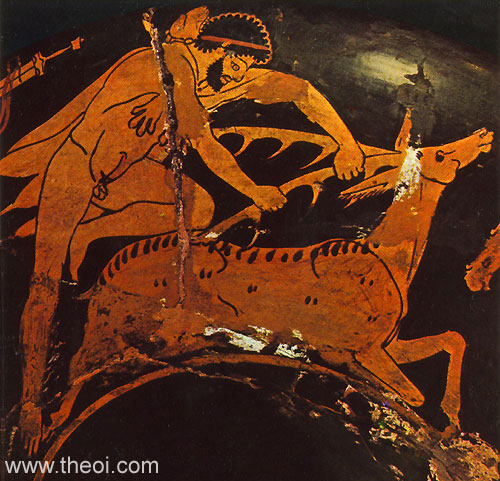
Pseudo-Apollodorus, Bibliotheca 2. 81 (trans. Aldrich) (Greek mythographer C2nd A.D.)
:
"His [Herakles' (Heracles')] third labour was to bring back alive to Mykenai (Mydenae) the Kerynitian Hind
(Elaphos Kerynitis). It was at Oinoe, a golden-horned deer sacred to Artemis. In his desire neither to
kill nor to wound it, Herakles spent a whole year pursuing it. Finally the animal tired of the chase and took
refuge on the mountain known as Artemision (Artemisium), and from there proceeded to cross the Ladon River. As
it was crossing, Herakles got it with an arrow, hoisted it on his shoulders pressed on urgently through Arkadia
(Arcadia). Artemis along with Apollon accosted him on the way, reached for the Hind, and berated him for trying
to kill her sacred animal. But Herakles pleaded necessity and said that Eurystheus was to blame, and thus
soothed the goddess' wrath; and he brought the animal still living to Mykenai."
Callimachus, Hymn 3 to Artemis 98 ff (trans. Mair) (Greek poet C3rd B.C.)
:
"Thou [Artemis] didst find by the base of the Parrhasian hill deer gambolling--a mighty herd. They always
herded by the banks of the black-pebbled Anauros--larger than bulls, and from their horns shone gold. And thou
wert suddenly amazed and sadist to thine own heart : ‘This would be a first capture worthy of
Artemis.’ Five were there in all; and four thou didst take by speed of foot--without chase of dogs--to
draw thy swift car. But one escaped over the river Keladon (Celadon), by devising of Hera, that it might be in
the after days a labour for Herakles, and the Keryneian (Cerynian) hill received her . . .
A golden car didst thou [Artemis] yoke, and golden bridles, goddess, didst thou put on thy deer. And where first
did thy horned team begin to carry thee?"
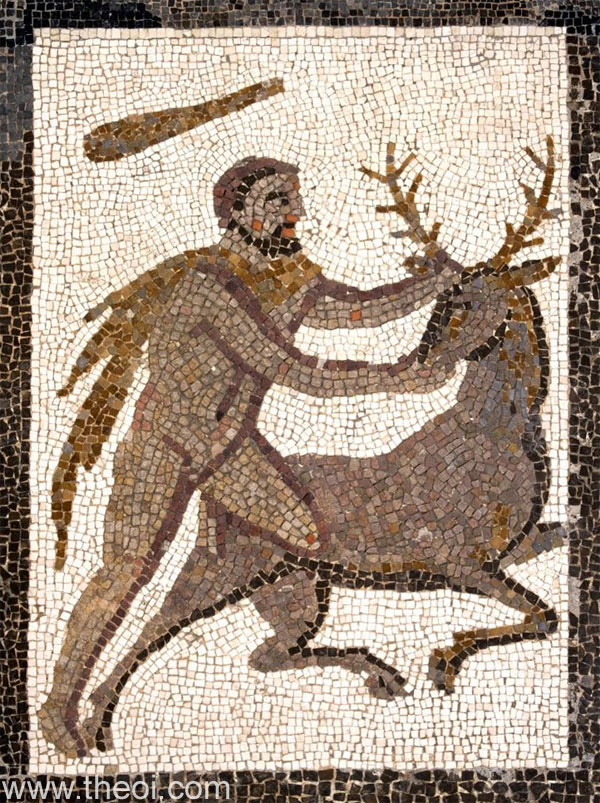
Diodorus Siculus, Library of History 4. 12. 13 (trans. Oldfather) (Greek historian
C1st B.C.) :
"The next Command [the fourth Labour] which Herakles (Heracles) received was the bringing back of the hart
which had golden horns [the Kerynitian (Cerynitian) Hind] and excelled in swiftness of foot. In the performance
of this Labour his sagacity stood him in not less stead than his strength of body. For some say that he captured
it by the use of nets, others that he tracked it down and mastered it while it was asleep, and some that he wore
it out by running it down. One thing is certain, that he accomplished this Labour by his sagacity of mind,
without the use of force and without running any perils."
Quintus Smyrnaeus, Fall of Troy 6. 223 ff (trans. Way) (Greek epic C4th A.D.)
:
"[Depicted on the shield of Herakles' son Eurypylos :] There fashioned was the fleetfoot stag [Kerynitian
(Cerynitian) Hind] which laid the vineyards waste of hapless husbandmen. The Hero's [Herakles'] hands held fast
its golden horns, while it snorted breath of ravening fire."
Aelian, On Animals 7. 39 (trans. Scholfield) (Greek natural history C2nd A.D.)
:
"Euripides says in his Temenidae that the ‘Labour’ [Kerynitian (Cerynitian) Hind] of
Herakles had horns, in the following verses : ‘And he came in quest of the golden-horned deer, braving one
fearful task in his mighty labours, over mountain haunts to meadows untrodden, and to groves where flocks
graze.’
And the Theban minstrel [Pindar] in one of his Epinician odes sings thus : ‘Necessity laid upon him
[Herakles] by Eurystheus through his father urged him to fetch the hind with the golden horns (elaphos
khrysokeros).’"
Pseudo-Hyginus, Fabulae 30 (trans. Grant) (Roman mythographer C2nd A.D.) :
"The wild stag with golden horns in Arcadia he [Herakles] brought alive to show Eurystheus." - Hyginus, Fabulae 30
Seneca, Hercules Furens 222 ff (trans. Miller) (Roman tragedy C1st A.D.) :
"[The labours of Herakles :] The nimble hind of Maenalus, raising her head bounteously adorned with gold,
was caught by his long pursuit."
ANCIENT GREEK & ROMAN ART
SOURCES
GREEK
- Apollodorus, The Library - Greek Mythography C2nd A.D.
- Callimachus, Hymns - Greek Poetry C3rd B.C.
- Diodorus Siculus, The Library of History - Greek History C1st B.C.
- Aelian, On Animals - Greek Natural History C2nd - 3rd A.D.
- Quintus Smyrnaeus, Fall of Troy - Greek Epic C4th A.D.
ROMAN
- Hyginus, Fabulae - Latin Mythography C2nd A.D.
- Seneca, Hercules Furens - Latin Tragedy C1st A.D.
OTHER SOURCES
Other references not currently quoted here: Pindar Olympian Ode 3, Euripides Heracles 378.
BIBLIOGRAPHY
A complete bibliography of the translations quoted on this page.
